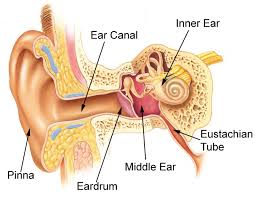How We Hear?
First, here are the parts of the ear:

- The outer ear
- The outer ear is made up of
the ear flap and the ear
canal up to the eardrum.
- The ear flap is also called the auricle or pinna.
- The eardrum is also called the tympanic membrane.
- The outer ear protects the middle and inner ears.
- The middle ear
- The middle ear is made up of three tiny bones
and the Eustachian tube.
- The Eustachian tube connects the middle ear to the
back of the throat. It opens and closes to make the pressure between the
inner and outer ears the same.
- Three tiny bones connect the
eardrum to the inner ear. The bones are called the hammer (malleus), anvil (incus) and stirrup (stapes).
- The inner ear
- The inner ear is made of the vestibular apparatus and the cochlea.
- The vestibular apparatus is three looping canals. They
control your balance.
- The cochlea turns sound into electrical
signals that get sent to the brain. The cochlea is spiral-shaped.
Now, here's how sounds get from the
outside to our brains.
- Sound
moves from the outside to your outer
ear.
- The outer ear passes sound to the middle ear.
- Your middle ear passes sound to your inner ear.
- Sound
makes your eardrum vibrate like a drum.
- The
vibrations pass to the three tiny bones behind the eardrum. (These are
the hammer, anvil and stirrup.)
- The
bones pass the vibrations to the inner
ear.
- The
vibrations go to the cochlea in your inner ear.
- Tiny
hair cells in the cochlea pick up the vibrations.
- The
hair cells turn the vibrations into electrical signals.
- The
electrical signals are sent to the auditory
nerve, and then the brain.
- Your
brain decides what the sound is.
- The auditory cortex is the part of the brain where
the signals are put with other information. The other information could
be what you see, and your memories.
- This
helps us to "know" what we're hearing. (For example, you hear a
car honk and think, "That's a car honking.")
How
Our Hearing Changes As We Grow?
A child's hearing changes a lot until he is 4 to 8 years old.
Your child can hear things even before he's born.
After he's born, here's how his hearing changes:
Your child can hear things even before he's born.
After he's born, here's how his hearing changes:
At birth:
- Responds to loud noises
- Turns to the sound of his
parents' voice
3 to 6 months:
- Can hear softer sounds
- Can tell one sound from another
- Still can't hear all sounds
The
Sounds We Hear
Facts about sound
- Sound travels through the air
as waves you can't see.
- The faster the waves are, the
higher the sound.
- How fast a sound travels is
called its frequency.
Frequency (or pitch) is also how high or low a sound is. - High-pitched sounds (like a
squeal) have a higher frequency.
- Low-pitched sounds (like
thunder) have a lower frequency.
- Frequency is measured in hertz (Hz).
- The bigger the waves, the
louder the sound.
- The loudness of sound is
measured in decibels
(dB).
What people with normal hearing can hear?
People with normal hearing can hear from about 0 dB to 140 dB.
Here's how loud those sounds can be:
People with normal hearing can hear from about 0 dB to 140 dB.
Here's how loud those sounds can be:
Sound
|
Loudness, in dB
|
Whisper
|
About 20 dB
|
Refrigerator humming
|
About 40 dB
|
Normal conversation
|
About 60 dB
|
Noise of traffic in the city
|
About 80 dB
|
Lawn mower
|
About 90 dB
|
Chainsaw
|
About 110 dB
|
Firecracker
|
About 140 dB
|
People with normal hearing can hear sounds as low as 20 Hz.
Some can hear as high as 20,000 Hz. Here's how high or low those sounds can be:
Some can hear as high as 20,000 Hz. Here's how high or low those sounds can be:
Sound
|
High or low sounds, in Hz
|
Thunder
|
20 Hz to 80 Hz
|
Talking
|
250 Hz to 6,000 Hz
|
Opera singer hitting a high note
|
2,000 Hz
|
What children with hearing loss can hear?
No comments:
Post a Comment